The Siena Civic Museum, the Museo Civico, was built in the 1930s on the first and second floors of the Palazzo Pubblico. Its visit (about an hour) is highly recommended, as the museum to be discovered in Siena.
It preserves many masterpieces of Sienese art, with particular attention to two remarkable rooms of the Globe and the Nine, of which paintings related to the government of the Nine, which was committed to the well-being of citizens and illustrated it here.
The palace still houses the city council.
First Floor
Art Gallery
The first four rooms (called the Pinacoteca) house works from the 16th to 18th century, including a sketch of the Virgin and Child with Saints by Sodoma, 1537-39 (originally placed in the Piazza Chapel (1537-1539).
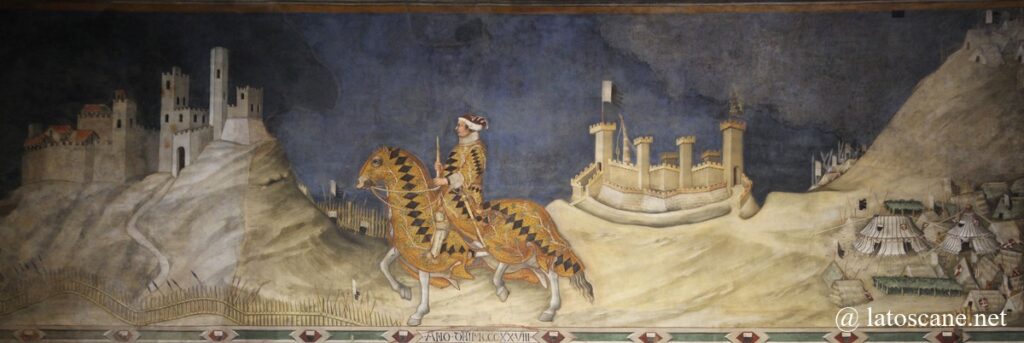
Risorgimento Hall
The Sala del Risorgimento is decorated with 19th century frescoes and sculptures, which are based on the historical period of the Italian Risorgimento, created by Tuscan and above all Sienese artists.
Balia Hall
The Sala di Balia (also called Pope’s Hall) is named after Balia, the permanent body that sat in the room from 1455. It was decorated in the early 15th century by Martino di Bartolomeo and Spinello Aretino with ceiling frescoes depicting the Virtues and on the walls the life of Alexander III, a Sienese pope. The beautiful carved wooden door by Domenico di Niccolò.
Hall of the Cardinals
The Cardinalate Hall, also known as the Consistory’s Anteroom, is decorated with various frescoes, some of which are attributed to Anbrogio Lorenzetti, from the 14th and 15th centuries, which come from other parts of the building or from the exterior walls.
Consistory Hall
A marble portal, by Bernardo Rossellino in 1448, leads to the Consistory Hall. Here the city leaders of the time of the Sienese Republic met.
On the vault, the allegorical frescoes by Domenico Beccafumi (1529-1535) represent the three virtues considered necessary for good government: love of the homeland, justice and harmony (or mutual benevolence).
The walls are decorated with gobelin tapestries. The frieze illustrates scenes from Greek and Roman mythology.
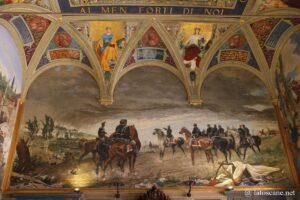
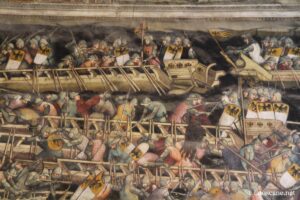
Vestibule and Anti-Chapel
A Madonna and Child by Ambrogio Lorenzetti (1340 approximately) decorates the vestibule, which was originally in the Loggia dei Nove. There is also the golden wolf that feeds the twins, sculpted by Giovanni di Turino in 1430, which was on the column at the entrance of the Palace.
The Anti-chapel was painted by Taddeo di Bartolo around 1415, illustrating mythological themes and elements of Roman history, the virtues necessary for good government, including the cardinal virtues (Justice, Strength and Prudence), illustrious men like Cicero, Judas Macabeus, Scipio the African, Cato the Elder, etc embodying these virtues.
Palace Chapel
Taddeo di Bartolo also decorated the chapel of the palace, with frescoes from around 1407 depicting scenes from the Life of the Virgin, evangelists, saints, prophets.
It also includes works by Giovanni di Turino, an altar designed by Marrina, and the Holy Family with Saint Leonard by Sodoma (1530).
The carved and inlaid wooden choir is a refined work by Domenico di Niccolò (1415-1428).
The organ was built between 1519 and 1525 by Giovanni di Antonio detto il Piffaro. The wrought iron grille is a work of 1437.
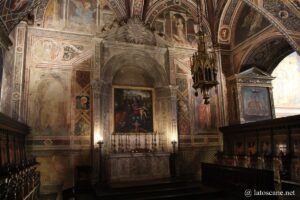
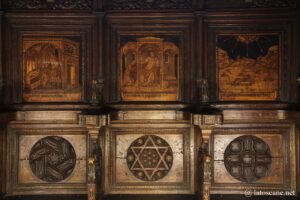
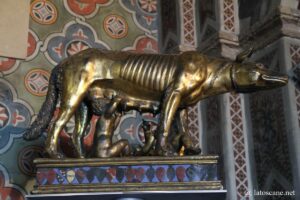
Globe Room
The Globe Room (or World Map Room) is the largest room in the palace, also designated as the Council Room. It preserves two remarkable large frescoes with the Maestà (Majesty) of the Virgin on her throne with the child and saints by Simone Martini (1312-1315) and Guidoriccio de Fogliano on his horse at the seat of Montemassi attributed to Simone Martini (1330). However, the latter would be a replica of the 15th of a lost work by Martini. Below this is represented the Taking of a castle perhaps that of Giuncarico, which would be by Duccio Buoninsegna (1314). Before he was finding a large globe painted by Ambrogio Lorenzetti in 1345 that was hung on the wall but has disappeared.
Other frescoes adorn the walls, from the 14th to the 16th century, celebrating victories won by Siena over Florence: the battaglia della Val di Chiana and the battaglia del Poggio Imperiale.
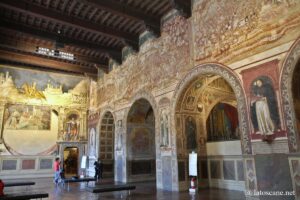
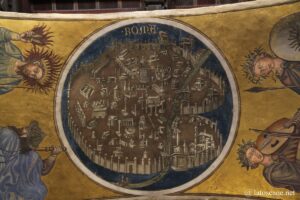
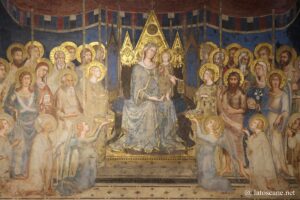

Hall of the Nine
The Hall of the Nine is the one after the Hall of the Globe. These two rooms are the most important in the palace.
Also called the Peace Hall, it preserves on three walls famous frescoes by Ambrogio Lorenzetti with the Allegory and the Effects of good and bad government (1338-1339). It is probably the most fascinating work within these museums, see in Siena whole, remarkable example of political allegory, with a vast representation of landscapes and secular subjects as religious.
This vast composition illustrates and personifies the abstract concepts that are named below. Two landscapes want to reveal the effects on the city and countryside, one of good government, the other of bad government.
Unfortunately, some of the Bad Government is erased.
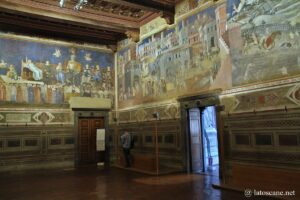
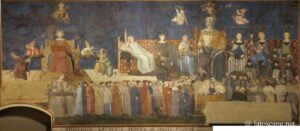
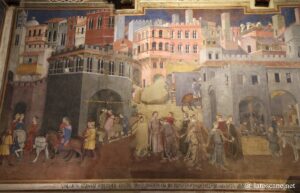
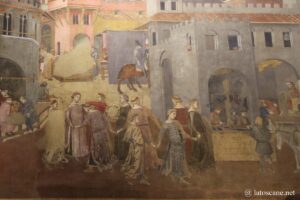
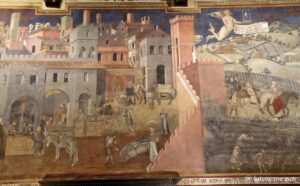
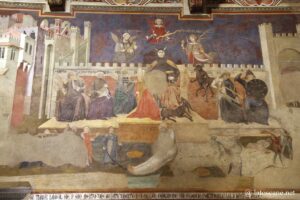
Other rooms on the first floor
Column Room
The Hall of Columns contains works from the 14th and 15th centuries.
Loggia
A staircase decorated with the fresco of Neroccio Bartolomeo Landi’s Madonna (1481) leads to the second floor, with its three rooms and the Loggia supported by four pillars. There is a beautiful view of the market square and a view of the southern half of Siena.
Second floor rooms
The Sala del Capitano del Popolo (People’s Captain’s Hall) is now the meeting room of the City Council. It is decorated with two paintings by Amos Cassioli.
In the other rooms there is a collection of prints, paintings from the 17th and 18th centuries, a portrait gallery, maps and documents on Siena and the Palio.
In the first room is the fresco of the Crucifixion by Pietro di Giovanni d’Ambrogio (1446) and in the second a ceiling from 1680.
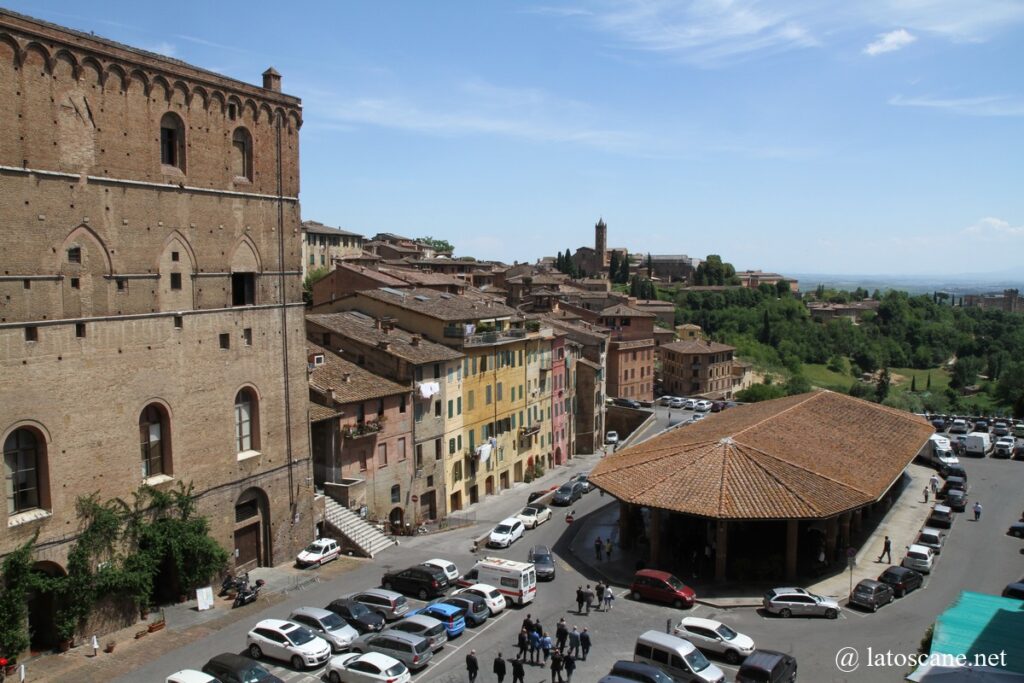
Where is the Civic Meseum of Siena, map
If you see this after your page is loaded completely, leafletJS files are missing.
Entrance tickets and reservations
Links and sources
- Official websites : museocivico.comune.siena.it
- Informations : en.wikipedia.org
Articles about Siena
- Siena
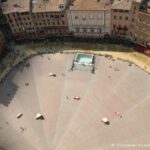 Siena is with Florence one of the most attractive destinations in the region. City of the famous palio, an equestrian race, it is a unique medieval town located in the ...
Siena is with Florence one of the most attractive destinations in the region. City of the famous palio, an equestrian race, it is a unique medieval town located in the ... - Things to do and see in Siena
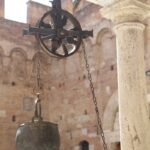 Siena deserves plenty of days to measure its charm. However, it is not a very large city and two days can be enough to bring back beautiful memories. Piazza del Campo ...
Siena deserves plenty of days to measure its charm. However, it is not a very large city and two days can be enough to bring back beautiful memories. Piazza del Campo ... - Piazza del Campo in Siena
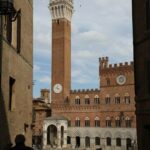 The Piazza del Campo is undoubtedly one of the most beautiful and elegant squares in the world, built between 1293 and 1349. It is the heart of the city of ...
The Piazza del Campo is undoubtedly one of the most beautiful and elegant squares in the world, built between 1293 and 1349. It is the heart of the city of ... - Siena Cathedral
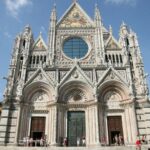 The Siena Cathedral dedicated to Assumption of Mary (Cattedrale di Santa Maria Assunta in Italian) stands out for its white and black stones and marble is certainly one of the ...
The Siena Cathedral dedicated to Assumption of Mary (Cattedrale di Santa Maria Assunta in Italian) stands out for its white and black stones and marble is certainly one of the ... - Palazzo Pubblico in Siena
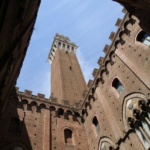 The most imposing building in Piazza del Campo is the Palazzo Pubblico with the very large tower next to the Torre della Mangia. Also called Communal Palace, it was built ...
The most imposing building in Piazza del Campo is the Palazzo Pubblico with the very large tower next to the Torre della Mangia. Also called Communal Palace, it was built ... - Palio di Siena
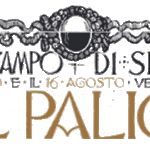 The Palio of Siena is a famous equestrian race that pits the different districts of the city (called the contrade), whose origins date back to the medieval games, held on ...
The Palio of Siena is a famous equestrian race that pits the different districts of the city (called the contrade), whose origins date back to the medieval games, held on ... - Santa Maria della Scala Hospital
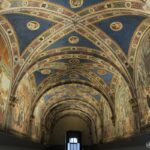 The ancient hospital for pilgrims, Santa Maria della Scala, is home to a vast and rich museum complex in Siena that covers 19,000 m 2. It is an essential step ...
The ancient hospital for pilgrims, Santa Maria della Scala, is home to a vast and rich museum complex in Siena that covers 19,000 m 2. It is an essential step ... - Fountains and bottini of Siena
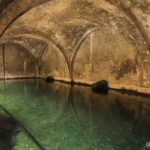 In Siena there are some fountains, fed by the bottini, the galleries of a medieval underground aqueduct built from the 12th century. These galleries are 25 km in length, channelling ...
In Siena there are some fountains, fed by the bottini, the galleries of a medieval underground aqueduct built from the 12th century. These galleries are 25 km in length, channelling ... - Palaces in Siena
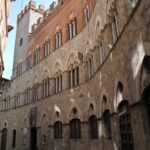 The streets of Siena are charming with their splendid palaces, most of them from the Middle Ages, some dating back to the Renaissance. They do not lack elegance with their ...
The streets of Siena are charming with their splendid palaces, most of them from the Middle Ages, some dating back to the Renaissance. They do not lack elegance with their ... - Pinacoteca Nazionale in Siena
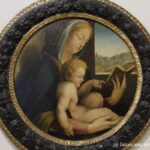 The Pinacoteca Nazionale di Siena is an important Italian museum, especially for its collection of ” paintings on gold background ” from the 14th and 15th centuries in Siena. It ...
The Pinacoteca Nazionale di Siena is an important Italian museum, especially for its collection of ” paintings on gold background ” from the 14th and 15th centuries in Siena. It ... - Basilica of San Dominico in Siena
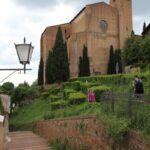 The Basilica di San Domenico in Siena, also known as Basilica Cateriniana, is one of the most important churches in the city, with its imposing Gothic architecture and Renaissance works. ...
The Basilica di San Domenico in Siena, also known as Basilica Cateriniana, is one of the most important churches in the city, with its imposing Gothic architecture and Renaissance works. ... - Saint Catherine Sanctuary in Siena
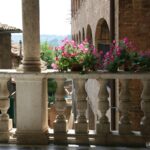 The Sanctuary of Saint Catherine of Siena (Santuario-Casa di Santa Caterina) is located on Hill San Antonio in Siena, consisting of the old house of the Benincasa, the family of ...
The Sanctuary of Saint Catherine of Siena (Santuario-Casa di Santa Caterina) is located on Hill San Antonio in Siena, consisting of the old house of the Benincasa, the family of ... - Other churches in Siena
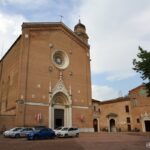 Basilica of Saint Francis in Siena The Basilica of San Francesco di Siena is one of the most important churches in Siena, located on the homonymous square. Between 1228 and 1255, ...
Basilica of Saint Francis in Siena The Basilica of San Francesco di Siena is one of the most important churches in Siena, located on the homonymous square. Between 1228 and 1255, ... - Gates and other sights of Siena
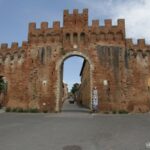 This page is dedicated to other interesting places in Siena, including its walls and gates, loggias, the Medici Fortress, some squares and streets of the center. Walls and gates of Siena Siena ...
This page is dedicated to other interesting places in Siena, including its walls and gates, loggias, the Medici Fortress, some squares and streets of the center. Walls and gates of Siena Siena ... - Tickets and guided tours in Siena
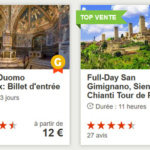 Tickets and proposals for guided tours in Siena, entrance tickets, city tours, with the cathedral complex, Piazza del Campo, excursions in the surrounding area, activities, etc Into the same category
Tickets and proposals for guided tours in Siena, entrance tickets, city tours, with the cathedral complex, Piazza del Campo, excursions in the surrounding area, activities, etc Into the same category - Interactive map of Siena
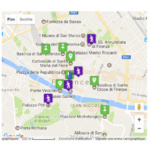 Carte de Sienne interactive avec les principaux monuments et les lieux secondaires, églises, palais et musées
Carte de Sienne interactive avec les principaux monuments et les lieux secondaires, églises, palais et musées - Hotels and accommodations in Siena
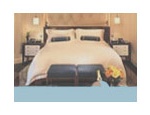 Book now accommodation in Siena, between hotel, rooms and apartments. Hundreds of choices with customer ratings
Book now accommodation in Siena, between hotel, rooms and apartments. Hundreds of choices with customer ratings - Short history of Siena
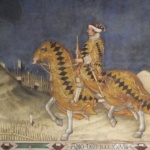 Although it seems that the Etruscans had occupied the territory of Siena, its foundation dates from the time of the emperor Augustus where a Roman colony was established under ...
Although it seems that the Etruscans had occupied the territory of Siena, its foundation dates from the time of the emperor Augustus where a Roman colony was established under ...
No Comments Yet